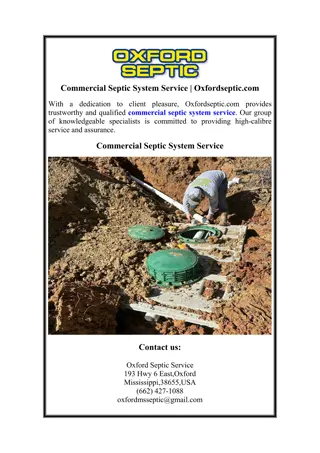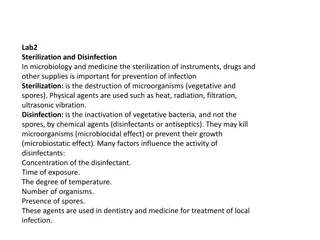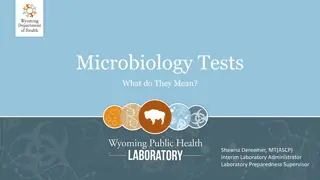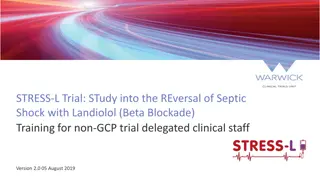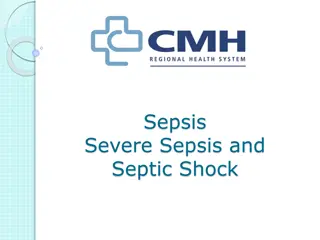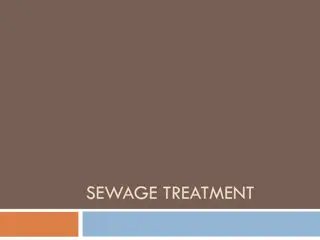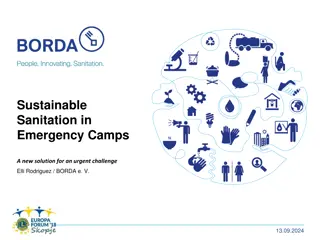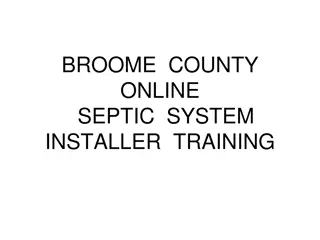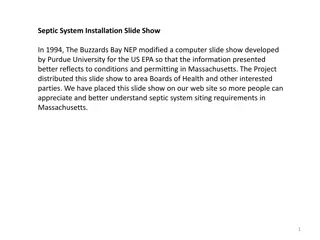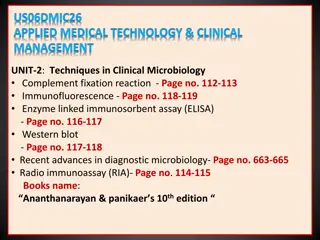Understanding Microbiology Lab Results: Case Study of Mrs. Septic's Infection
In this case study, Mrs. Septic's blood cultures are growing gram-positive cocci, leading to a differential diagnosis involving various bacterial pathogens. Through a series of microbiology lab findings, the causative organism, Staphylococcus aureus, is identified. Further complications arise, indicating toxic shock syndrome likely caused by the toxin TSST-1. This case highlights the importance of interpreting microbiology results in diagnosing and managing infections accurately.
Download Presentation

Please find below an Image/Link to download the presentation.
The content on the website is provided AS IS for your information and personal use only. It may not be sold, licensed, or shared on other websites without obtaining consent from the author. Download presentation by click this link. If you encounter any issues during the download, it is possible that the publisher has removed the file from their server.
E N D
Presentation Transcript
You are paged by the Microbiology Lab and told that blood cultures drawn from your patient, Mrs. I. M. Septic, are growing gram-positive cocci. Mrs. Septic is a 42-year-old woman who was admitted with a fever and malaise. Which of the following is NOT a possible cause of your patient's infection? A. Enterococcus faecium B. Streptococcus pyogenes C. Staphylococcus aureus D. Staphylococcus epidermidis E. Listeria monocytogenes
Anxious to narrow the differential diagnosis on Mrs. Septic, you ask the Microbiology Lab for more information. They state that they have not yet identified the organism, but they have shown that it is catalase positive. Which two of the following organisms are possible? A. Enterococcus faecium B. Streptococcus pyogenes C. Staphylococcus aureus D. Staphylococcus epidermidis
C. and D. Streptococci and enterococci are catalase negative. Staphylococci are catalase positive.
The next morning you again call the microbiology laboratory. They now tell you that Mrs. Septic's bacterium is also coagulase positive. Which organism is the cause of Mrs. Septic's infection? C. Staphylococcus aureus D. Staphylococcus epidermidis
C. Staphylococcus aureus is coagulase positive whereas Staphylococcus epidermidis is coagulase negative.
When you return to tell Mrs. Septic that you have identified the organism that is making her ill, you notice that she is febrile, hypotensive, is vomiting and has diarrhea and an erythematous rash. She states that she is currently menstruating. Which of the following toxins is most likely causing Mrs. Septic's symptoms? A. exfoliatin B. TSST-1 C. alpha-toxin D. coagulase E. pyrogenic exotoxin A
B. Mrs. Septic has the signs and symptoms of toxic shock syndrome. Thus TSST-1 is the most likely causative toxin. Note that although bacteremia is not necessary in the pathogenesis of toxic shock syndrome, bacteremia may still be present in these patients.
Which of the following organisms is NOT a common cause of food-poisoning? A. Staphylococcus aureus B. Yersinia enterocolitica C. Pseudomonas aeruginosa D. Salmonella enterica E. Bacillus cereus
C. Pseudomonas aeruginosa is a frequent cause of hospital-acquired infections, but usually does not cause food poisoning.
All of the following organisms are associated with cardiac damage and abnormalities EXCEPT: A. Clostridium difficile B. Staphylococcus aureus C. Corynebacterium diphtheriae D. Borrelia burgdorferi E. Streptococcus pyogenes
A. Clostridium difficile causes antibiotic-associated diarrhea and colitis, but not cardiac damage. Staphyloccocus aureus is a frequent cause of endocarditis, Corynebacteria diphtheriae can cause cardiac damage through the action of diphtheria toxin, Borrelia burgdorferi is associated with arrhythmias, and Streptococcus pyogenes can cause rheumatic fever.
Which of the following is a strict anaerobe? A. Corynebacterium diphtheriae B. Actinomyces israelii C. Bordetella pertussis D. Yersinia pestis E. Nocardia asteroides
A 34-year-old man presents to the Emergency Room complaining of fever, a stiff neck, and pain upon looking at bright lights. You suspect meningitis. All of the following are likely causes of his illness EXCEPT: A. Streptococcus pneumoniae B. Listeria monocytogenes C. Bordetella pertussis D. Neisseria meningitidis E. Haemophilis influenzae
C. Bordetella pertussis usually causes whooping cough, whereas the other listed organisms are frequent causes of meningitis.
Upon further questioning, you determine that he works on a dairy farm and recently drank some unpasteurized milk. This information supports which of the following as a cause of his symptoms? A. Streptococcus pneumoniae B. Listeria monocytogenes D. Neisseria meningitidis E. Haemophilis influenzae
B. Listeria monocytogenes is a cause of meningitis that may be obtained by drinking unpasteurized mild.
You perform a lumbar puncture. A gram-stain of the cerebral spinal fluid shows gram-negative diplococci. Which of the following is the most likely cause of the man's illness? A. Streptococcus pneumoniae B. Listeria monocytogenes D. Neisseria meningitidis E. Haemophilis influenzae
D. Neisseria meningitidis is a frequent cause of meningitis that is a Gram-negative diplococci (cocci that are often paired).
Extra Credit Question The man states that he had an anaphylactic response to penicillin in the past. What should you use to treat him? A. penicillin B. ceftriaxone C. trimethroprim/sulfamethoxazole D. gentamicin E. chloramphenicol
E. Chloramphenicol is the treatment of choice for patients with Neisseria meningitidis meningitis who have a severe allergy to penicillin.
Regarding this case, which of the following is true? A. Household members should receive meningococcal vaccine. B. Household members should receive ciprofloxacin. C. Household members should receive penicillin. D. A lumbar puncture should be performed on all household members to determine who should receive treatment. E. Throat cultures should be performed on all household members to determine who should receive antibiotics.
B. Household members exposed to a patient with Neisseria meningitidis meningitis should receive ciprofloxacin prophylaxis, since they are at a significantly increased risk of acquiring the disease. Rifampin and ceftriaxone are also acceptable options.
A throat culture is mistakenly ordered on a patient on your service who is hospitalized for a diabetic foot ulcer. Her throat looks normal and she denies any oropharyngeal symptoms. You are surprised when the Clinical Microbiology Laboratory calls you to say that the culture is growing Neisseria meningitidis. Which of the following would be appropriate: A. Start treatment immediately with penicillin and place the patient in respiratory isolation. B. Immunize her with the meningococcus vaccine. C. Immunize the patient's family members as well as the physicians and nurses who have cared for her with the meningococcus vaccine. D. Administer ciprofloxacin to the patient's family members as well as the physicians and nurses who have cared for her. E. Take no action.
E. Take no action. The patient s throat is transiently colonized with Neisseria meningitidis, but he is not currently experiencing disease. Approximately 10% of the population will be colonized with this bacterium at any given time. Therefore no treatment or other measures is necessary.
Which of the following is true regarding Neisseria meningitidis? A. This organism secretes siderophores to obtain iron from host tissues. B. This organism has a capsule which is the target of a vaccine. C. This organism causes a sexually transmitted disease. D. This organism is a Gram-negative rod. E. A single commercially available vaccine is effective against all strains of this organism.
B. Neisseria spp. do not secrete siderophores. Neisseria gonorrhoeae causes a sexually transmitted disease, not Neisseria meningitidis. This organism is a Gram-negative diplococcus, not rod. A vaccine against the polysaccharide capsule is used, but is only effective against capsular types A, C, and Y. A separate vaccine is effective against capsular type B.
Which of the following is NOT a spirochete? A. Treponema pallidum B. Borrelia burgdorferi C. Borrelia recurrentis D. Leptospira interrogans E. Helicobacter pylori
E. Helicobacter pylori is a Gram-negative spiral- shaped organism, but is not considered a spirochete.
The bacterium that causes Lyme Disease makes which bacterial protein? A. VacA B. ActA C. OspA D. OmpA E. dot
C. OspA is an surface protein of Borrelia burgdorferi. VacA is a Helicobacter pylori protein, ActA is a Listeria monocytogenes protein, and dot is a genetic locus in Legionella pneumophila.
Which of the following is NOT a Rickettsia species important in human disease? A. Rickettsia typhi B. Rickettsia tsutsugamushi C. Rickettsia prowazekii D. Rickettsia burnetti E. Rickettsia rickettsia
D. burnetti is a species of Coxiella not Rickettsia. Rickettsia typhi causes murine typhus, R. tsutsugamushi causes scrub typhus, R. prowazekii causes epidemic typhus, and R. rickettsia causes Rocky Mountain Spotted Fever.
Which of the following media/agars is routinely used to grow Legionella pneumophila? A. Buffered charcoal-yeast extract agar B. Sheep red blood cell agar C. MacConkey s agar D. Bordet-Gengou media E. Tellurite selective media
A. Buffered charcoal yeast extract agar is commonly used to grow Legionella pneumophila. This agar is supplemented with cysteine and antibiotics, which aid in the growth and selection of Legionella.
Which of the following organisms causes an illness characterized by a catarrhal stage. A. Listeria monocytogenes B. Bordetella pertussis C. Legionella pneumophila D. Bacillus anthracis E. Coxiella burnetti
B. Bordetella pertussis causes whooping cough, a disease consisting of three stages: (1) an incubation stage, (2) a catarrhal stage, and (3) a paroxysmal stage, during which the characteristic whooping cough occurs.
Your patient is admitted to the surgical intensive care unit following a car accident leading to abdominal trauma. He undergoes abdominal surgery for removal of his spleen, which has ruptured. He remains intubated following the surgery, and on post-op day 3 develops a fever and infiltrate on his chest XRay. Sputum and blood cultures grow an organism that is a rod by Gram-stain. Which of the following is the least likely etiology for this patient s pneumonia? A. Klebsiella pneumoniae B. Pseudomonas aeruginosa C. Citrobacter freundii D. Enterbacter cloacae E. Legionella pneumophila
E. All have a Gram-negative structure to their cell walls, but Legionella pneumophila usually does not take up Gram-stain. It is visualized using other stains, such as silver stain or DFA.
Preliminary analysis of the organism by the Microbiology Laboratory indicates that it is oxidase positive. Which of the following is/are possible causes of the patient s pneumonia? A. Klebsiella pneumoniae B. Pseudomonas aeruginosa C. Citrobacter freundii D. Enterbacter cloacae
B. Only Pseudomonas aeruginosa is a Gram-negative rod that is oxidase positive.
The laboratory says that antibiotic susceptibilities on the P. aeruginosa isolate are pending. Which of the following is an appropriate treatment regimen for this patient? A. Ampicillin B. Ceftazidime C. Azithromycin D. Cefazolin E. Trimethoprim-Sulfamethoxazole
B. Of the antibiotics listed, only ceftazidime has activity against P. aeruginosa.
Which of the following is not associated with the cell wall of Gram-positive bacteria? A. Lipopolysaccharide B. Murein C. Teichoic acid D. Peptidoglycan E. Penicillin-binding proteins
A. Lipopolysaccharide is associated with the outer membrane of Gram-negative bacteria.
Which of the following is the toxic portion of lipopolysaccharide? A. O-side chain B. Core polysaccharide C. Lipid A D. KDO E. ribotol
C. Lipid A is responsible for the toxic activity of LPS, which can lead to Gram-negative shock.
H antigen refers to which of the following: A. Pili B. Capsule C. Flagella D. LPS E. Peptidoglycan




